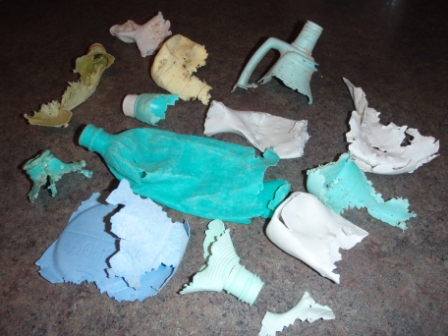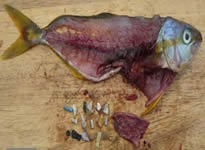Do you play catch with your son? How about on the beach? Did the ball go into the water? Could you get it back? Did you watch it float away? Why? Did you think it wouldn’t do anything? It did. I found it.
– Kasper 7th-8th grader, Odyssey Multiage Program
Beach “Treasures” Recovered During A Beach Plastic Odyssey: Alarming quantities of plastic litter are spotted daily in our seas worldwide, both in the waters and along the shoreline. A stunning 90% of all marine debris is plastic, and 80% of that plastic is coming from land.
Having read these statistics, my family can no longer have innocent beach days devoid of facing the impact we’ve had on our watersheds and shore environments. It hasn’t taken long for us all (from ages 4 – 74, grandparents included) to step into the role of citizen scientists, wanting to solve the questions of what exactly is floating in our waters and where is it coming from? But doing it alone was too high a plastic mountain to climb, so we’ve developed a community-based project, along with the Rockefeller Campbell family, called Plastic is Forever, a citizen-science project for all ages to study the effects of everyday plastics in our local waters. Our methods employed are varied, but they involve a combination of simple hands-on science, mathematical inventorying, treasure hunting, taxonomy of unknown plastic parts, and a good bit of creative spirit through art and film.
On their final days of school this year, the Odyssey 7-8th grade class of 2010-2011 took part in our pilot educational project to raise awareness that the problem of plastics in the marine environment is not just out in the North Pacific Gyre, but dramatically right here under our very noses.
The Beach Forays and What We Found: A one-hour foray by 40 students to a local beach reaped sad, yet typical, results. The list of common debris found mimics the most commonly used items in our region: bottle caps, straws, plastic pens, and (in the case of Puget Sound) fireworks. To qualify this last item, you have to imagine the 4th of July from any Puget Sound vantage point: an admittedly beautiful display of countless private pyrotechnics that, on the calm waters of the Sound, mirror beautifully skyward and then seaward.
Each firing over our waters, however, is a literal throwing-away-of-plastics-and-blown-up-plastic-bits into the Sound. By January, those pieces are washing up by the tens of thousands along our local shores, mixed with seaweed, wood bits, and the myriad other common plastics on our everyday list. Here’s a sampling of hot items found during 5 trips to Puget Sound beaches by a team of four K-1 students in March of 2010:
Balloons & Ribbons: 10
Bottle Caps: 87.5
Candy Wrappers: 38
Earplugs: 52
Fireworks Parts: 134
Construction Foam: Infinite
Fishing Tackle Floats: 34
Marine Rope: 85 feet
Microplastic Pieces: Infinite
Miscellaneous Broken Plastic Pieces: 1140
Miscellaneous Unknown Plastic Parts: 220
Pens: 17
Pen Parts: 30
Plastic Bags: 27
PVC Tubing: 70 inches
Shoes: 8.5
Shotgun Cartridges: 71.5
Drinking Straws: 57.2
Styrofoam: Infinite
Syringes: 4.5
Water Bottles: 18
Ziplock Bags: 10
When I look at this list, I first think of what’s missing: The number-one most-used material plastic in our country — polyethylene or “film.” Translated: plastic bags. They are also the least-recycled plastic worldwide. Why aren’t we finding hundreds of plastic bags in a month of visiting our local beaches? The answer is simple: they’re already absorbed into the environment, having first been ingested by land-lubber scavengers like raccoons and dogs. Add to that the fact that plastic bags are the first of the plastics to photo-degrade in salt water into unintelligible tiny bits mixed in with the translucent seaweeds of our marine ecosystem. Take a Mason jar the next time you go to the beach and collect a jar-full of seaweed sludge. How much of it is organic and how much synthetic? In the winter months, the amount of torn up broken-down synthetics is alarming. And then there’s another clue in those jars: tiny fish bites (some not so tiny) taken out of what’s left of the plastic bags. They’re there, and if they’re not made by fish, harbor seals, otters, then they’re made by raccoons or other predators who encountered the plastic bag housing tasty remnants of human foodstuffs during the landward part of the bag’s journey.
It’s the obvious absence of plastic bags on our beaches that is most disturbing. The majority are made from petroleum — a nonrenewable resource. Very few are recycled into more bags or other types of plastic. The hundreds of plastic bags used in each American household every year simply end up in a landfill or in our waterways, never breaking down completely, making their way down to the sea. A 2001 study cited on the website of the U.S. Environmental Protection Agency (EPA) and the UNEP (United Nations Environmental Programme) shows that of 38 sea turtles examined, 60% had ingested marine debris, mostly plastic bags. According to some websites, 60 – 100 million barrels of oil are required to make the world’s plastic bags each year.
But it’s not just about the oil and the turtles, raccoons, fish, harbor seals, Laysan albatross, and even whales that we know are ingesting our discarded plastics. I often think about the communities of mussels thriving on large pieces of styrofoam, floating freely across our waters. There’s good evidence they injest the plastic toxins and release them into our waters.
We’re learning that plastics themselves, without the help of the bivalves, along with pesticides and even common prescription drugs are releasing synthetic and natural hormones into rivers and streams, which is leading to unintended consequences on wildlife, causing some male fish, for example, to become feminized and lay eggs. In a recent report, it was found that one third of small mouth bass were feminized in nine major U.S. river basins, and almost all of the rivers and streams tested in the United States contained some hormonally active chemicals. Our pure waters are purely reflecting our unintentional impact and irresponsible handling of waste, even if it’s waste from our bodies after consuming prescription drugs and birth-control pills.
Christopher Bartlett of The Magic Snorkel.com has documented the work of Captain Charles Moore while trawling the Pacific Garbage Patch. I’ll quote him directly as these facts about marine plastics are not my expertise but important to understand:
Plastics absorb Persistent Organic Pollutants (POPs) from paint chips, coolants, pesticides, and metals, so when fish eat plastic matter and then bigger fish eat them, the chemicals could be bioaccumulating. Do the micro plastic particles contain POPs, and do these harmful pollutants migrate into the tissues and organs of the fish that ingest them and subsequently enter into the human food chain? Concentrations of the most frequent POPs (PCBs, DDT, and PAH – all renowned for their effects on the human organism) on nurdles collected from Japanese coastal waters were found to be up to 1 million times higher than the levels detected in surrounding seawater, the new data from the NPSG could have far-reaching effects.
If you want to have a personal encounter with nurdles, the feedstock of all items made of plastic (and washing up by the millions on our shores,) come to our exhibit at Bainbridge Performing Arts this July.
Earplugs? Why are we finding so many earplugs washing onto our beaches? We’d love to hear your thoughts. Construction workers? Boaters? Swimmers? They come in every color: purple, dayglo yellow, green, pink/green, orange. Next time you go to the beach, walk along the wrack line, (high tide line) and try to NOT find an earplug or 2 and a balloon piece with a ribbon tied to the end of it.
But you might be one of those people who just can’t see these plastics underfoot. They blend in — or we’ve tuned them out – and most plastics we find in the high tide debris can be seen mimicking something we typically see in the natural world. White and black plastic netting (used in the fishing industry to hold clams, mussels, oysters) look just like some forms of seaweed. Black PVC tubing looks like dark waterlogged sticks. Even the ribbons on the ends of balloons look like seaweed. My dear friend and fellow plastic citizen scientist, Rebecca Rockefeller, picked up a chunk of fish roe from the wrack line in one hand and in the other a similar-size chunk of styrofoam, same hue of orange with the same-size synthetic “eggs.” If I were a hungry large fish or otter, I’d be all over that sty-roe-foam. There’s no doubt these plastics have entered the food chain and, indeed now, our bodies.
The following 6-minute film documents the Beach Plastic Odyssey project and its impact upon a thoughtful and creative group of 7th and 8th graders. We thank them for their enthusiasm and clear insights they gave us on our first journey down the path of teaching environmental awareness. We did have a few doubters on day one: “I’ve spent a lot of time at Fort Ward beach and have never seen any plastics.” But, by the end of the study, there was little doubt that plastic debris washes up onto our shorelines with every high tide.
Here are some enlightening conclusions from the Odyssey 7th-8th grade team:
What lifestyle change(s) might be necessary to reduce your plastic consumption?
When we bring our lunch, we can use metal containers and not plastic ones.
Recycling, bring fabric bags to Safeway, or stop buying unnecessary things.
Bringing reusable water bottles
Reusing things
Recycle
Use less water bottles – reuse them
What other conclusions, if any, can you draw?
I can conclude that a lot of things we use have alternatives and we just need to be willing to use the alternatives.
Don’t litter, don’t use plastic too much.
The fascinating results of the students’ work, including reflection sheets, and an inventory, can be seen at Bainbridge Performing Arts, starting July 1 though August along with works of art created from found debris on our local beaches by local artists. Meanwhile, we hope you enjoy the film:


Recycling doesn’t have to be difficult.
LikeLike
Maybe we can do our share disposing of our items properly. Pick up items found near storm drains and reduce your consumption of plastic based products. Check this video out.
LikeLike
Pingback: Mapping Plastic: A Circumnavigation of Bainbridge Island | Pioneering The Simple Life: One Family's Journey Back to the Future